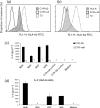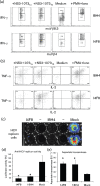Generation of T-cell receptors targeting a genetically stable and immunodominant cytotoxic T-lymphocyte epitope within hepatitis C virus non-structural protein 3
- PMID: 22071510
- PMCID: PMC3352347
- DOI: 10.1099/vir.0.037903-0
Generation of T-cell receptors targeting a genetically stable and immunodominant cytotoxic T-lymphocyte epitope within hepatitis C virus non-structural protein 3
Abstract
Hepatitis C virus (HCV) is a major cause of severe liver disease, and one major contributing factor is thought to involve a dysfunction of virus-specific T-cells. T-cell receptor (TCR) gene therapy with HCV-specific TCRs would increase the number of effector T-cells to promote virus clearance. We therefore took advantage of HLA-A2 transgenic mice to generate multiple TCR candidates against HCV using DNA vaccination followed by generation of stable T-cell-BW (T-BW) tumour hybrid cells. Using this approach, large numbers of non-structural protein 3 (NS3)-specific functional T-BW hybrids can be generated efficiently. These predominantly target the genetically stable HCV genotype 1 NS3(1073-1081) CTL epitope, frequently associated with clearance of HCV in humans. These T-BW hybrid clones recognized the NS3(1073) peptide with a high avidity. The hybridoma effectively recognized virus variants and targeted cells with low HLA-A2 expression, which has not been reported previously. Importantly, high-avidity murine TCRs effectively redirected human non-HCV-specific T-lymphocytes to recognize human hepatoma cells with HCV RNA replication driven by a subgenomic HCV replicon. Taken together, TCR candidates with a range of functional avidities, which can be used to study immune recognition of HCV-positive targets, have been generated. This has implications for TCR-related immunotherapy against HCV.
Figures








Similar articles
-
Hepatitis C Virus-Specific T Cell Receptor mRNA-Engineered Human T Cells: Impact of Antigen Specificity on Functional Properties.J Virol. 2017 Apr 13;91(9):e00010-17. doi: 10.1128/JVI.00010-17. Print 2017 May 1. J Virol. 2017. PMID: 28228595 Free PMC article.
-
Relation between viral fitness and immune escape within the hepatitis C virus protease.Gut. 2006 Feb;55(2):266-74. doi: 10.1136/gut.2005.072231. Epub 2005 Aug 16. Gut. 2006. PMID: 16105887 Free PMC article.
-
Targeting naturally occurring epitope variants of hepatitis C virus with high-affinity T-cell receptors.J Gen Virol. 2017 Mar;98(3):374-384. doi: 10.1099/jgv.0.000656. Epub 2017 Apr 1. J Gen Virol. 2017. PMID: 27902325 Free PMC article.
-
TCR-redirected human T cells inhibit hepatitis C virus replication: hepatotoxic potential is linked to antigen specificity and functional avidity.J Immunol. 2012 Nov 1;189(9):4510-9. doi: 10.4049/jimmunol.1201613. Epub 2012 Sep 28. J Immunol. 2012. PMID: 23024278
-
Cross-reactivity between hepatitis C virus and Influenza A virus determinant-specific cytotoxic T cells.J Virol. 2001 Dec;75(23):11392-400. doi: 10.1128/JVI.75.23.11392-11400.2001. J Virol. 2001. PMID: 11689620 Free PMC article.
Cited by
-
Process Development for Adoptive Cell Therapy in Academia: A Pipeline for Clinical-Scale Manufacturing of Multiple TCR-T Cell Products.Front Immunol. 2022 Jun 16;13:896242. doi: 10.3389/fimmu.2022.896242. eCollection 2022. Front Immunol. 2022. PMID: 35784320 Free PMC article.
-
Lack of Heterologous Cross-reactivity toward HLA-A*02:01 Restricted Viral Epitopes Is Underpinned by Distinct αβT Cell Receptor Signatures.J Biol Chem. 2016 Nov 18;291(47):24335-24351. doi: 10.1074/jbc.M116.753988. Epub 2016 Sep 19. J Biol Chem. 2016. PMID: 27645996 Free PMC article.
-
Hepatitis C Virus-Specific T Cell Receptor mRNA-Engineered Human T Cells: Impact of Antigen Specificity on Functional Properties.J Virol. 2017 Apr 13;91(9):e00010-17. doi: 10.1128/JVI.00010-17. Print 2017 May 1. J Virol. 2017. PMID: 28228595 Free PMC article.
-
Chronic Viral Liver Diseases: Approaching the Liver Using T Cell Receptor-Mediated Gene Technologies.Cells. 2020 Jun 16;9(6):1471. doi: 10.3390/cells9061471. Cells. 2020. PMID: 32560123 Free PMC article. Review.
References
-
- Ahlén G., Söderholm J., Tjelle T., Kjeken R., Frelin L., Höglund U., Blomberg P., Fons M., Mathiesen I., Sällberg M. (2007). In vivo electroporation enhances the immunogenicity of hepatitis C virus nonstructural 3/4A DNA by increased local DNA uptake, protein expression, inflammation, and infiltration of CD3+ T cells. J Immunol 179, 4741–4753 - PubMed
-
- Badr G., Bédard N., Abdel-Hakeem M. S., Trautmann L., Willems B., Villeneuve J. P., Haddad E. K., Sékaly R. P., Bruneau J., Shoukry N. H. (2008). Early interferon therapy for hepatitis C virus infection rescues polyfunctional, long-lived CD8+ memory T cells. J Virol 82, 10017–10031 10.1128/JVI.01083-08 - DOI - PMC - PubMed
Publication types
MeSH terms
Substances
LinkOut - more resources
Full Text Sources
Molecular Biology Databases
Research Materials

